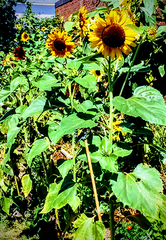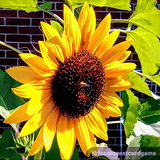
Plants are a constant source of wonder and delight. If you are like me, you still have many questions about why plants work the way they do. One thing I only recently understood was how, and why, sunflowers follow the sun from sunrise to sunset. Nature conserves energy, therefore any regular behavior implies efficiency. My assumption was that sunflower heads might absorb light for photosynthesis, but how could a flower do this, since flowers are not constructed like leaves? And by what action can a flower move? I did a bit of digging and found several interesting answers to the how and why.
How does a plant move in the first place? Plants do not have muscles, tendons or bones. The answer, at least for sunflowers, is growth hormones. Yes, plants, like animals, have hormones. Hormones are used to make cells do things. They regulate growth, development and (as we all know) reproduction. In plants, these hormones are called “phytohormones”.
 One class of phytohormones is called “auxins”. Auxins decide what grows when. In the sunflower, auxins are used to stimulate growth in a way that causes the top of the plant to bend back and forth. As the sun moves, the auxins follow the shade, so the shady side grows faster, pushing the top of the plant toward the sun. At night, a circadian clock resets the process. The auxins return to the other side of the stalk, and the head swings back as this side grows. Recently, scientists at the University of California, Davis have discovered that, while auxins do avoid sunlight, this behavior isn’t only caused by light. In fact, a flower will remember this circadian rhythm and continue the pattern of movement for several days, even if the plants are placed in a darkened room. The behavior will eventually stop but will start again when the plants are placed back in the sun. This type of patterned memory is a prime example of what scientists are beginning to call "plant intelligence".
One class of phytohormones is called “auxins”. Auxins decide what grows when. In the sunflower, auxins are used to stimulate growth in a way that causes the top of the plant to bend back and forth. As the sun moves, the auxins follow the shade, so the shady side grows faster, pushing the top of the plant toward the sun. At night, a circadian clock resets the process. The auxins return to the other side of the stalk, and the head swings back as this side grows. Recently, scientists at the University of California, Davis have discovered that, while auxins do avoid sunlight, this behavior isn’t only caused by light. In fact, a flower will remember this circadian rhythm and continue the pattern of movement for several days, even if the plants are placed in a darkened room. The behavior will eventually stop but will start again when the plants are placed back in the sun. This type of patterned memory is a prime example of what scientists are beginning to call "plant intelligence".
When a stalk stops growing, the flower can no longer move. Generally, mature sunflowers face the direction of the morning sun (east). If they were still acting like solar panels, it would be more efficient to settle somewhere between east and west, cheating more toward the afternoon sun. Until recently, the reason for this east-facing preference was a mystery.
So, the question now becomes, "why should a sunflower face the sun when it is growing?"
The answer, as I suspected, lies in energy collection and conservation, but the reasons are complex and, perhaps, not perfectly understood. The movement appears to be aimed purely at getting the most sunlight possible. The face of a sunflower is encircled by “bracts”, or a crown of green leaves. These leaves can collect sunlight and, when the plant is immature, they cover the entire face of the flower, making the flower a big, leafy solar panel. As the head of the flower moves from east to west, the entire top of the plant swings back and forth. This directs many young leaves toward the sun, making photosynthesis more efficient for that section of the plant.
So why does the flower face east when the plant is mature?
 Again, the answer is efficiency. Those same UC, Davis scientists discovered that sunflowers facing east warm their flowers more quickly in the mornings. While this might seem like a small advantage, it is actually very helpful, and might also explain the dark coloration at the center of the flower. Sunflowers that warm early were found to attract five times more pollinizers than those that the scientists turned, artificially, in the opposite direction. Insects appreciate warm flowers, and those big, brown discs warm up fast when they’re facing the sun. More insects results in more reproduction (fertilized sunflower seeds), and more reproduction is, clearly, an advantage in the wild.
Again, the answer is efficiency. Those same UC, Davis scientists discovered that sunflowers facing east warm their flowers more quickly in the mornings. While this might seem like a small advantage, it is actually very helpful, and might also explain the dark coloration at the center of the flower. Sunflowers that warm early were found to attract five times more pollinizers than those that the scientists turned, artificially, in the opposite direction. Insects appreciate warm flowers, and those big, brown discs warm up fast when they’re facing the sun. More insects results in more reproduction (fertilized sunflower seeds), and more reproduction is, clearly, an advantage in the wild.
Much of the information in this post was only recently discovered. I did not realize most of it until very recently. Plants continue to hold mysteries, many of which we will never solve. This is part of what makes gardening, and food forests, such an exciting field of study.
Sunflowers in the Food Forest
As food forest plants, sunflowers are self-seeding annuals, meaning they will come back, year after year, unless you remove the flowers before seeds drop. Tall varieties can be used to create a sturdy trellis for pole beans or other climbing annuals. Sunflowers create great quantities of biomass and edible seeds which can be pressed into oil. They also attract pollenizers to your garden which, as any gardener will tell you, is a really good thing!
